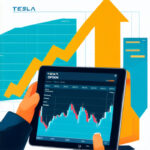Top 5 Factors Influencing Tesla’s Premarket Stock Price Today

Introduction to Tesla’s Premarket Stock Price
Tesla isn’t just another car company; they’re the Apple of electric vehicles—and their stock is just as sizzling. If you’ve ever wondered why Tesla’s share price seems to go haywire before the market even opens, you’re in the right place. Let’s dive into what drives Tesla’s premarket action and how it all ties back to investor sentiment, company news, and the broader EV revolution.
Premarket trading is like a sneak peek into what’s cooking before the main event. It happens from 4:00 AM to 9:30 AM ET, giving traders and investors a chance to react to breaking news or earnings reports. For Tesla fans, this early window often reflects how excited (or nervous) people are about the company’s latest moves. Whether it’s a new product launch or an earnings miss, premarket trading is where the real show starts.
Earnings Reports and Financial Performance
Here’s the thing: Tesla’s earnings reports aren’t just numbers on a page—they’re like report cards for the company. Investors are always looking for signs that Tesla is staying ahead of the game. If revenue skyrockets or they manage to keep costs in check, it’s party time in premarket trading. But if the results fall short of expectations? Brace yourself for some serious volatility.
Recent years have been a rollercoaster for Tesla. Revenue has been growing like wildfire, thanks to surging EV demand and expanding production lines. But let’s not forget—the company isn’t immune to hiccups. Supply chain snags, rising costs, or unexpected setbacks can throw a wrench in things. And when they do? Investors are quick to react—whether it’s with celebration or caution.
Product Launches and Innovations
Tesla’s reputation as an innovation powerhouse isn’t just hype—it’s real, and it drives their stock price. When Elon Musk unveils a new vehicle or teases a breakthrough in battery tech, it’s like dropping a bomb on Wall Street. Take the Cybertruck, for instance. The mere mention of delays or updates can send premarket trading into a frenzy. Why? Because Tesla’s products aren’t just cars—they’re symbols of the future.
Production updates are another hot topic. Can Tesla keep up with demand? Will they hit their ambitious targets? These questions loom large over premarket trading. If there’s good news about ramping up production, it’s a green light for investors. But if delays pop up? Prepare for some serious sell-offs before the market even opens.
Supply Chain and Manufacturing Challenges
If you think building electric cars is a breeze, think again. Tesla’s supply chain is like a high-stakes game of Jenga—tweak one piece, and the whole thing could come crashing down. From semiconductor shortages to logistical bottlenecks, any hiccup in the supply chain can send shockwaves through the company—and its stock price.
That said, Tesla isn’t just sitting back and taking it. They’re doubling down on diversifying suppliers and investing big in battery production. But here’s the kicker: even with all this planning, unexpected challenges—like skyrocketing raw material costs or geopolitical tensions—can still throw a wrench in things. For investors, staying ahead of these developments is key to navigating the volatility.
Regulatory and Policy Changes
Government policies might not be the sexiest topic, but they’re a huge deal for Tesla. Positive changes—like extended EV tax credits or investments in charging infrastructure—are like gifts from Santa for investors. But when regulations tighten or trade disputes heat up? It’s a whole different ballgame. Investors are always keeping an eye on how these shifts might impact Tesla’s growth and market access.
Let’s be honest—navigating the regulatory landscape is no walk in the park. One policy tweak could open doors for Tesla, while another might close them shut. It’s all about staying ahead of the curve and understanding how these changes fit into the bigger picture.
Competition in the Electric Vehicle Market
If there’s one thing Tesla doesn’t have to worry about, it’s a lack of competition. Automakers like Ford and GM are throwing everything they’ve got into the EV race, and new players like Rivian are making waves too. The question is: can Tesla keep its edge? If a rival comes out swinging with an affordable, feature-packed EV, it could shake things up in a big way—especially in premarket trading.
For now, Tesla still holds the crown as the EV kingpin. But if the competition starts to close the gap? Investors will be quick to reassess their bets. Pricing strategies and innovation will be key to keeping that crown—and for investors, staying tuned into these developments is a must.
Macroeconomic Trends and Investor Sentiment
Tesla’s stock isn’t just influenced by company-specific factors—it’s also tied to the broader economic climate. Interest rates, inflation, oil prices—these big-picture trends can make or break investor sentiment. For example, if interest rates rise, it could crimp Tesla’s borrowing costs and reduce demand for high-growth stocks like theirs.
Oil prices are another wild card. When they dip, EV adoption might slow down a bit. But when they surge? It’s a whole different story—EVs start looking even more attractive. Throw in shifts in investor risk appetite during times of economic uncertainty, and you’ve got a recipe for some serious premarket fireworks.
Conclusion: Navigating the Factors That Move Tesla’s Stock
So there you have it—the wild ride that is Tesla’s premarket stock price. From earnings reports to supply chain snafus, competition to macroeconomic trends, there’s no shortage of factors keeping investors on their toes. The key? Staying informed and adaptable in a world where the only constant is change.
Want to stay ahead of the curve? Set up alerts for earnings announcements or regulatory updates. Diversify your portfolio to spread out the risk. And most importantly, keep a long-term perspective—Tesla’s journey isn’t just about tomorrow; it’s about shaping the future of transportation as we know it.
So here’s to the road ahead—a bumpy one for sure, but with plenty of twists and turns that could make for some seriously exciting trading. Buckle up, folks—the ride is far from over.

Laura Henderson is an enthusiast and has been writing on cutting-edge topics for years.







